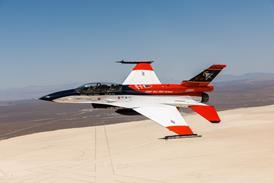GUY NORRIS / LOS ANGELES
Pratt & Whitney will virtually restart the Airbus A318 PW6000 programme, after setbacks have allowed CFM International (CFMI) to come from nowhere, overtake the incumbent, and assume pole-position. The result is a 30-month effort by P&W, based on the MTU-designed six-stage HDV12 high-pressure compressor (HPC), to resolve the performance snags that have dogged the engine from its initial tests.
Although P&W appears to have had good warning that the once-rejected MTU design was the ready-made answer to boosting compressor flow and reducing fuel-burn, why has it fought so doggedly to use its home-grown five-stage design? Aside from value-per-engine factors, P&W's focus on its simpler core reflected a determination to cut parts count and costs to a minimum.
Arguments that the PW6000 would involve costs around one-third that of the CFM56 were convincing, and until Air France opted for the commonality of the existing engine, P&W enjoyed virtual exclusivity on the A318 from the moment of its launch.
The subsequent problems, and its decision in early 2002 to delay entry-into-service by 30 months to mid-2005, have seen a gradual erosion of its market as Frontier Airlines followed International Lease Finance in switching to the CFM56. Added to the loss of TWA's A318 order following its take-over by American Airlines the previous year, P&W's stranglehold has disappeared.
In view of the extensive changes to the PW6000 which will come with the likely selection of the MTU HPC (expected around 15 May) over an indigenous seven-stage HPC option, P&W says: "We are just not ready to talk about it". It adds, however, that, should the MTU decision be positive, the German company will negotiate for a risk-revenue shareholding of between 15 and 20%. MTU is a life-time preferred vendor to the PW6000 with its low pressure turbine, but as Flight International went to press, not yet a full partner.
CFMI is busy applying for joint European and US certification of two new CFM56-5B variants for the A318. Launch customer Frontier will receive its first A318 in July next year.
The baseline -5B8/P is rated at 21,600lb (96kN) and the -5B9/P provisionally at 23,300lb. These engines will be derated versions of the A319/A320/A321's -5B family, which is capable of higher thrust, and is rated at 32,000lb on the A321. So CFMI's savings are bundled up in the dramatic derating of the A318 operation, and commonality benefits of inter-operability, shared spares and maintenance. "We will use an identical bill of materials for the -5B in service on A318s, A319s, A320s and A321s," says CFM56-5 programme general manager Ken Foley.
Although not enjoying the installed weight benefit of the PW6000, "the commonality advantage outweighs anything else," Foley adds. Early CFM56-powered A318 operators flying other A320 family members are expected to "mix and match" -5B engines to manage life cycle and maintenance costs. The idea will be to remove higher-thrust rated engines from A321s, de-rate them and put them on A318s for another two years of service before removal. Conversely, new engines intended ultimately for A318s, will provide initial power on A321s before being swapped.
The de-rated exhaust gas temperature margin of the -5B8/9 is so large, says Foley, that a life of 20,000 cycles on wing before major overhaul is expected. The dual annular combustor option is offered on the B9 but not on the B8, as emission certification tests were not conducted at this lower power level.
Source: Flight International
















